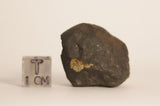Chelyabinsk 20.7g Meteorite Complete
LL5 Chondrite Meteorite
Nice example of this famous newsworthy even in 2013.
- Name: Chelyabinsk - This is an OFFICIAL meteorite name.
- Abbreviation: None
- Observed fall: Yes
- Year fell: 2013
- Country: Russia
- Mass: 1000kg (Total)
- This example: 20.7g - Complete specimen
Everyone should remember this one!
The Chelyabinsk meteor was a near Earth asteroid that entered Earth's atmosphere over Russia on 15 February 2013 with a speed of 40,000 - 42,900 mph, almost 60 times thespeed of sound. It quickly became a brilliant Superbolide meteor. The light from the meteor was brighter than our Sun, even at 100 km distance. It was observed over a wide area of the region and in neighbouring republics. Eyewitnesses also felt intense heat from the fireball.
Due to its enormous velocity and shallow entry angle, the object exploded in an air burst over Chelyabinsk, at a height of around 29.7 km (18.4 miles). The explosion generated a bright flash, producing a hot cloud of dust and gas that penetrated to 26.2 km, and many surviving small fragmentary meteorites as well as a powerful shock wave. The atmosphere absorbed most of the object's energy, with a total kinetic energy before atmospheric impact equivalent to approximately 500 kilotons of TNT, 20–30 times more energy than was released from the Hiroshima Atomic Bomb.
Its explosion created panic among local residents and about 1,500 people were injured seriously enough to seek medical treatment. All of the injuries were due to indirect effects rather than the meteor itself, mainly from broken glass from windows that were blown in when the shock wave arrived, minutes after the superbolide's flash. Some 7,200 buildings in six cities across the region were damaged by the explosion's shock wave, and authorities scrambled to help repair the structures in sub-zero (°C) temperatures.
With an estimated initial mass of about 12,000–13,000 tons, and measuring about 20 metres in diameter, it is the largest known natural object to have entered Earth's atmosphere since the 1908 Tunguska event that destroyed a wide, remote, forested area of Siberia.
The Chelyabinsk meteor is also the only meteor confirmed to have resulted in a large number of injuries.
More information on the meteorite Chelyabinsk can be found here -
http://www.lpi.usra.edu/meteor/metbull.php?code=57165
OFFICIAL CLASSIFICATION DATA SOURCE:
The Meteoritical Society
As a member of the International Meteorite Collectors Association we guarantee the authenticity of every meteorite sold. We source them from specialist dealers and collectors worldwide.
All of our meteorites come with Specimen ID Card, COA and often a chain of custody of certificates of previous owners & collectors.
Our meteorites are individually listed, priced, and detailed. The one you buy is the exact one you receive.
Buy with confidence!

**Scale cube not included









